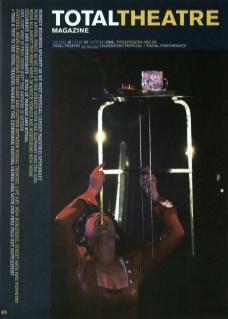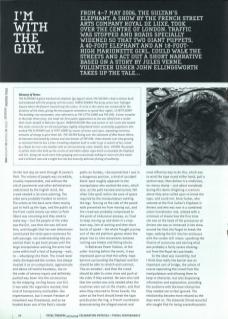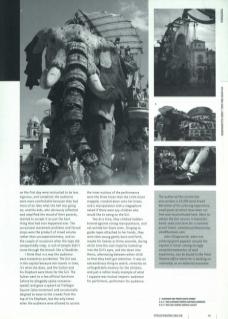Glossary of Terms: THE ELEPHANT A giant mechanical elephant (go figure) which THE SULTAN's chief architect built and endowed with the property of time travel. HORSE GUARDS The dusty arena near Trafalgar Square where the Queen's Guard troop the colour. A circle in the centre was closed off for the duration of the show, giving the two puppets somewhere to spend their nights. LE PETIT GÉANT The building-size marionette, also referred to as THE LITTLE GIANT and THE GIRL. A time-traveller in the Jules Verne story, she made her first public appearance as she was lifted from a rocket that crash-landed in Waterloo Square. MANIPULATEURS Men and women in red-coats who looked like room-service for an old and perhaps slightly dilapidated hotel; essentially puppeteers who worked THE ELEPHANT and LE PETIT GÉANT by means of levers and ropes, expending enormous amounts of energy to give them life. THE SULTAN Ruling over the Sultanate of Who Knows Where, he becomes distracted by intense and real dreams of THE GIRL, these dreams over time growing so insistent that he has a time-travelling elephant built in order to go in search of her, acted by a Royal de Luxe crew member with an extraordinarily calm, beatific face. USHERS The people in yellow shirts who held up the circles of red/white safety-tape which surrounded the Elephant and Girl, doing not much more than gripping and occasionally walking in return for free meals and a brilliant view and a slight but real but honestly delicious feeling of authority.
On the last day we went through St James's Park. The volume of people was incredible, visually impenetrable, and without the aid of pavements and other delimitations understood by the English mind, the crowd needed a lot more ushering. The sides were probably hardest to control. The ushers at the back were there mostly just to hold up the tape, and the public at the front could clearly see when Le Petit Géant was oncoming and they need to make way – but the people at the sides saw the Girl, saw that she was tall and thin, and thought that her own dimensions constituted the total space necessary for safe passage, not understanding why you wanted them to get back please until the large manipulateur working the arms had come within half a foot of bumping – wait, no – whumping into them. The crowd never really disrespected the cordon, but always treated it as an unimportant, approximate and above all tactile boundary, low on the order of sensory inputs and definitely pushed way down into the unconscious by the stepping, smiling house-size Girl. It was what the organisers wanted, that kind of transparency and bubble-like impermanence, but it meant freedom of movement was threatened, and as we headed down one of the Park's slender paths on Sunday, I discovered that I was in a dangerous position, a kind of accident black-spot roughly adjacent to the manipulateur who worked the arms, which also, as the path twisted and turned, fell often (the spot) within the zone of space required by the manipulateurs working the legs. Fencing at the side of the paved walk prevented me from moving out, and the crowd was probably compressed to the point of endurance anyway, so I had to keep moving up and down in a stop-start way, lots of waiting and then short bursts of speed – the whole fraught journey sort of like old platform games where the player has to time movements between running saw blades and falling blocks.
In Battersea Power Station, at the usher-training before the event, it was impressed upon us that the safety-tape barriers surrounding the Elephant and Girl should be able to stretch and contract, ‘like an amoeba', and that the crowd should be able to come close and push at the sides if they wanted. We were also told that the cordon was only needed when the machines were out on the streets, and that when they returned to Horse Guards, the usher at the front should break the tape and dissolve the ring, a French coordinator demonstrating the alleged easiest and most effective way to do this, which was to wind the tape round either hand, pull a section taut, then deliver it a vindictive, no-mercy stamp – just about everybody during this demo imagining a scenario where they were called upon to break the tape, and could not. Anne Tucker, who ushered at the first Sultan's Elephant in Amiens and who was now in a combined usher/coordinator role, related with a minimum of shame how the first time she was at the head of the procession at Amiens she was so immersed in the show around her that she forgot to break the tape, walking the Girl into her enclosure with the cordon still intact, upsetting the illusion of autonomy and earning what was probably a fairly severe chewing-out from the Royal de Luxe heads.
So the ideal was invisibility, but I think that really the barrier was an important sort of bridge, the ushers of course separating the crowd from the manipulateurs and allowing them to keep in character, but also dispensing information and explanation, providing the audience with the bare interaction they needed not to feel ignored. The relationship became more relaxed as the days went on. The stewards (hired security) who caught flak for being overenthusiastic on the first day were instructed to be less vigorous, and complied; the audience were more comfortable because they had more of an idea what the hell was going on; and the kids, who obviously reflected and amplified the mood of their parents, started to accept it as just the best thing that had ever happened ever. The occasional movement problems and forced stops were the product of crowd volume rather than uncooperativeness, and on the couple of occasions when the tape did unexpectedly snap, a rush of people didn't come through the breach like a floodtide.
I think that in a way the audience were treated as accidental. The Girl was in the capital because she travels in time, it's what she does, and the Sultan and his Elephant were there for the Girl. The Sultan went to a few official functions (where he allegedly spoke nonsensespeak) and gave a speech at Trafalgar Square (also nonsense) and occasionally deigned to wave to the crowds from the top of his Elephant, but the only times when the audience were allowed to access the inner nucleus of the performance were the three times that the Little Giant stopped, cranked down onto her knees, and a manipulateur with a megaphone asked if there were any children who would like to swing on the Girl.
Two at a time, they climbed ladders braced against strong manipulateurs, and sat astride her Giant arms. Clinging to guide ropes attached to her hands, they were then swung gently back and forth, maybe for twenty or thirty seconds, during which time the vast majority looked up into the Girl's eyes, and she down into theirs, alternating between either child so that they both got attention. It was an extraordinary thing to watch, certainly an unforgettable memory for the children, and just a rather lovely example of what I suppose was mutual respect: audience for performers, performers for audience.


